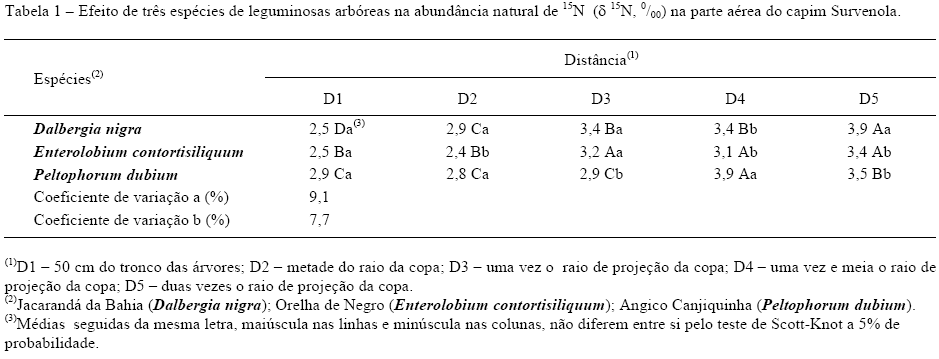This research was aimed at evaluating the effect on the transference of N from legume trees to Survenola grass (Hybrid between Digitaria setivalva e D. valida). Two of legume trees are N fixers, Dalbergia nigra (Jacarandá da Bahia) and Enterolobium contortisiliquum (Orelha de Negro), while Peltophorum dubium (Angico Canjiquinha) does not form nodules. Samples of Survenola grass were taken from D1) 50cm from trunk; D2) half of the canopy’s projection ray; D3) canopy’s projection ray; D4) one and a half of the canopy’s projection ray; D5) twice the canopy’s projection ray, which were considered control. The experiment was set up in a completely randomized split plot design, with three repetions, where each tree was treated as plot and the five sampling distances the subplots. The natural 15N abundance (delta15N, ‰) analysis was carried out using the mass spectrometer Delta Plus, Finnigan Mat, of Embrapa Agrobiologia. The delta15N values (‰) from the Survenola grass shoot clearly indicated that the contribution of N fixed occurred mainly closer to the legume trees trunks Dalbergia nigra and Enterolobium contortisiliquum presented greater delta15N values with the increase in distance of the canopy’s projection ray, indicating the recycling effect of the fixed N2 by the two legume trees. The grass N content derived from the legume trees varied from 0 to 38% but depended on leguminous species and distance. The N transferred from the legumes to the Survenola grass decreased with the sampling distance from the trunks of the tree species. The maximum N transfered from legumes to the grass was 29.9; 37.7 and 27.7% of the total N accumulated by Survenola grass, which was equivalent to 22.0; 16.7 and 8.2kg ha-1 of N for Enterolobium contortisiliquum, Dalbergia nigra e Peltophorum dubium, respectively.
silvopastoral; biological nitrogen fixation; Peltophorum dubium



